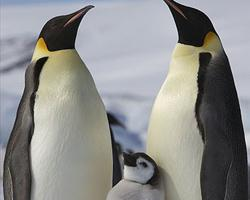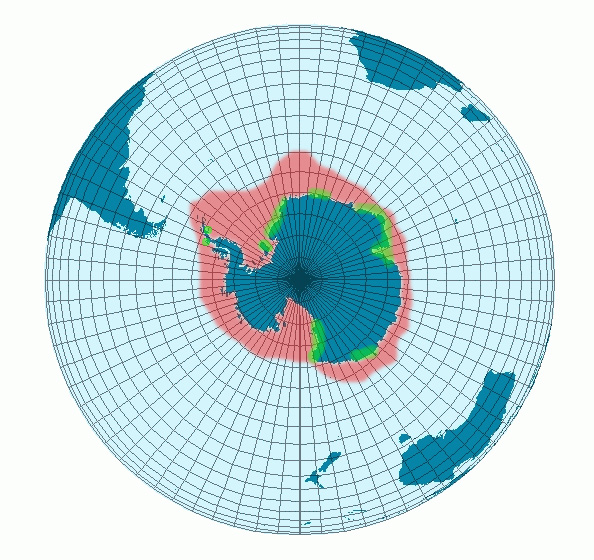
Poids et mesures
| Hauteur au garrot | 122 cm |
|---|---|
| Poids | de 22 à 45 kg |
Données biologiques
| Durée de vie | de 20 à 50 ans |
|---|
Statut de conservation
| Menacé |
Description de l'animal
The Emperor Penguin (Aptenodytes forsteri) is a remarkable species, standing as the tallest and heaviest of all living penguin species. Indigenous to Antarctica, these majestic birds are built to survive the harsh conditions of their icy habitat, exhibiting a range of fascinating adaptations that have captivated scientists and nature enthusiasts alike.Physical Characteristics:
Emperor Penguins can reach heights of up to 122 cm (48 inches) and weigh between 22 to 45 kg (49 to 99 pounds), with males typically larger than females. Their bodies are streamlined for efficient swimming, with powerful flippers used for propulsion and a sturdy tail to aid in steering. Their plumage is uniquely adapted to provide insulation against the cold; the outer layers of feathers are waterproof and tightly packed, trapping air beneath them to retain body heat. The distinctive black and white coloring serves as camouflage while swimming; the black back blends with the dark ocean depths when viewed from above, and the white belly merges with the bright surface when seen from below, protecting them from predators.
Habitat and Lifestyle:
Emperor Penguins are endemic to the Antarctic continent, thriving in conditions that would be lethal to most other species. They are uniquely adapted to the extreme cold, capable of surviving temperatures as low as -60°C (-76°F) and winds of up to 200 km/h (124 mph). Unlike other penguin species, Emperors breed during the Antarctic winter, trekking up to 120 km (75 miles) across the ice to reach their breeding sites. This incredible journey is undertaken in large groups, helping them conserve heat and increase their chances of survival against the elements and predators.
Reproduction and Lifecycle:
The breeding season begins in March or April when temperatures are at their most forbidding. After laying a single egg, the female transfers it to the male who then incubates it on his feet, covered by a fold of abdominal skin known as a brood pouch. During this time, the female returns to the sea to feed. The males endure around two months of fasting in the brutal Antarctic winter, surviving off stored fat reserves until the eggs hatch. Once the chicks are born, parents take turns feeding them a regurgitated mixture of fish, squid, and krill. The young are ready to fend for themselves by December or January, just as the Antarctic summer begins to take hold.
Diet:
Emperor Penguins primarily feed on fish, squid, and krill, diving to depths of over 500 meters (1640 feet) to hunt. They are capable of holding their breath for more than 20 minutes, an adaptation that allows them to reach such impressive depths. Their diet is rich in nutrients, essential for maintaining their energy levels in the cold and for females to produce eggs.
Conservation Status:
The Emperor Penguin is currently classified as Near Threatened by the International Union for Conservation of Nature (IUCN). Their main threats include climate change, which impacts ice conditions and thus breeding and feeding habitats; and industrial fishing, which reduces their primary food sources. Conservation efforts are focused on monitoring populations, protecting habitats, and regulating fishing activities to ensure these magnificent creatures can thrive for generations to come.
In conclusion, the Emperor Penguin is a symbol of resilience and adaptation, embodying the extreme conditions of its icy realm. Its life cycle, from the perilous winter breeding to the nurturing of chicks, showcases a remarkable commitment to survival. As ambassadors of the Antarctic, they remind us of the importance of preserving one of the planet's last wildernesses and the delicate balance that sustains life even in the most inhospitable places on Earth.
Carte de répartition

Animaux similaires
Nouvelles photos d'animaux
Top 10 des animaux
- Dolphin gull (Leucophaeus scoresbii)
- Diana monkey (Cercopithecus diana)
- Moustached guenon (Cercopithecus cephus)
- Galápagos tortoise (Geochelone nigra complex)
- Japanese macaque (Macaca fuscata)
- Russian tortoise (Testudo horsfieldii)
- Stone loach (Barbatula barbatula)
- Greek tortoise (Testudo graeca)
- Common flying dragon (Draco volans)
- Vendace (Coregonus albula)


